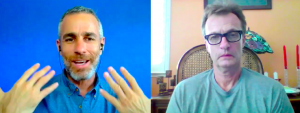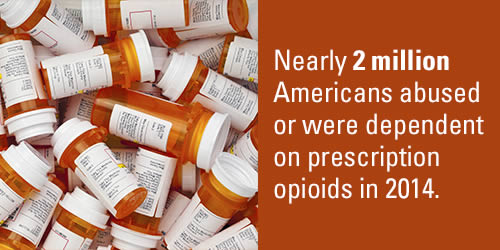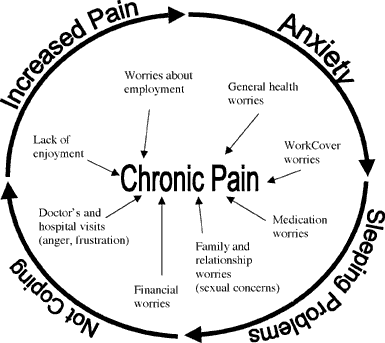
Tommy Rosen Interviews Peter Przekop, D.O., PhD, for Recovery 2.0
During this past week’s Recovery 2.0 online conference, founder and addiction specialist Tommy Rosen interviewed Peter Przekop, D.O., Ph.D. about the growing chronic pain epidemic in the face of a medical establishment ill-equipped to manage long-term pain without the use of potent pharmaceuticals, like opioids. The doctor of osteopathy developed and directed the pain management program at the Betty Ford Center or chemical dependence recovery for 6 years and is the current director of the pediatric chronic pain and headache clinic at Loma Linda University Medical School. In Friday’s interview, Przekop gave insight into challenges of treating chronic pain with Western medicine.
“Sixty percent of people that you see in practice as a primary care doctor complain of chronic pain,” he told Rosen, “and you don’t know what to do.”
A 2011 report from the National Academy of Medicine (formerly known as the Institute of Medicine) estimated that at least 100 million Americans live with chronic pain, a number that has certained increased in the eight years since the study was done. More Americans live with chronic pain than with cancer, coronary heart disease and diabetes combined, according to the American Academy of Pain Medicine.
Medical School Fails to Proper Address Chronic Pain
Yet Przekop said that his medical school offered no training for chronic pain–and only three hours for addiction. A 2012 study by Journal of Pain found that while approximately 80 percent of U.S. medical schools required 1 or more pain sessions, these studies were usually a part of a more general course and offered doctors-in-training less than five hours total in education. A significant number of U.S. schools offered no pain courses at all. The Journal Of Pain also noted that many topics included in the International Association for the Study of Pain core curriculum were not addressed; education pertaining to opioid painkillers, pediatric pain, cancer pain and geriatric pain are especially absent.
“Pain takes a very backseat course,” pain physician and Chief Medical Officer of American News Report Dr. Daniel Bennett told National Pain Report. He cited a dearth of funding for pain education at medical schools and a lack of long-term thinking by universities and industry as key contributors to the problem.
“In this country, for the largest reason that people seek medical care, which is pain, there is no residency available. There is no formal training for it outside of a year of fellowship,” he said. “So care is not uniform. The public has no idea what they’re getting when they see a spine physician, when they see a pain physician. This is a huge problem. What you have in this country are a lot of physicians who are being forced to manage pain but doing it incorrectly.”
With little to no formal pain education in medical schools, physicians are increasingly dependent on information and research funded and provided by pharmaceutical companies. Compounding a lack of knowledge about treating chronic pain, Przekop explained that a big push from pharmaceuticals in the ‘90s helped to pave the way to the opioid addiction epidemic that we have today. He said that, around 1992, the medical field began to acknowledge that there were a lot of patients suffering from chronic pain in the United States. According to Przekop, two small case reports, including one in The Journal of Pain, concluded that long-term use of opioids in patients was safe and carried no threat of addiction.
Big Pharma Pushes Physicians to Prescribe Opioids
“Afterward, pharmaceutical companies that made opioids made a hard push for physicians to use them,” he said. “Pain doctors were recruited to give talks to say this is what we need to do.”
These pharma-funded studies were not based on any research, claims Przekop. “Clinical trials showed that pain didn’t improve and that there was a 50 percent dropout rate after 6 weeks,” he said.
 Przekop recalls being taken out to a steakhouse by a sales representative of OxyContin producers Purdue Pharma as a resident in the late ‘90s, where he was told that OxyContin did not have a problem with dependence. “They pushed on weak research, on studies based on 24 hours or less,” he said. “Instead of [pharmaceutical recommendations being] based on sound clinical evidence, it was based more upon sales, advertising and trends.”
Przekop recalls being taken out to a steakhouse by a sales representative of OxyContin producers Purdue Pharma as a resident in the late ‘90s, where he was told that OxyContin did not have a problem with dependence. “They pushed on weak research, on studies based on 24 hours or less,” he said. “Instead of [pharmaceutical recommendations being] based on sound clinical evidence, it was based more upon sales, advertising and trends.”
Bennett told National Pain Report, “The majority of physicians understand pain drugs based on what the pharmaceutical rep tells them. So you have over prescription of opioids. You have overutilization of surgical devices. You have missed diagnoses.”
In his interview with Przekop, Rosen said, “If I’m a medical doctor, and patient comes into my office, and they’ve got a chronic pain situation, and unless I go outside the box, unless I have somehow on my own explored, as you have, alternative therapies, I’m going to probably end up prescribing some form of painkiller to my patient.”
Przekop replied, “If you send [patients] to a pain specialist, usually an anesthesiologist…they’ll give standard opioids, opioids for breakthrough pain. They can add a pump. It’s just the answer that we’ve used for the last 30 years doesn’t work. And we haven’t had an acknowledgment that it doesn’t work. We haven’t acknowledged that something else has to be done.”
A 2015 article by TIME magazine reports that 5 to 8 million Americans use opioids for long-term pain management. Opioid prescriptions skyrocketed from 76 million in 1991 to 219 million in 2011. According to RT, an estimated 5.4 million prescriptions for the best-selling painkiller OxyContin were written by physicians in the U.S. in 2014.
The extended-effect medication made its debut in 1996 and reached its height of popularity in 2010. According to TIME, Purdue Pharma accrued $31 billion in revenue based on the claim that the drug controlled pain for 12 hours. However, an L.A. Times investigation discovered that physicians and sales rep reports, clinical trials (funded by Purdue), and independent research revealed that the drug wears off in far less than 12 hours for many patients.
According to the Times, doctors were advised to treat their patients complaining of abbreviated relief from the drug by prescribing stronger doses, instead of more frequent ones.
In an 8 hour day filled with 35 patients, a physician has a half hour or less with each patient. “A chronic patient comes in and complains, ‘You gave me hydrocodone before, I’m still in pain and pain is getting worse,’ and they keep on complaining. You don’t have an answer,” Przekop explained. “The only thing you can do is increase it and prescribe more. This is a big problem we don’t have an answer to.”
Research has shown that the stronger the dosage of opioids, the greater the risk of abusing the medication and of overdose. Unfortunately, patients seeking to address their rapidly returning chronic pain are often desperate to take matters into their own hands. Suffering from symptoms of withdrawal from the drug, they rely on additional medication, sometimes going onto take illegal, uncontrolled drugs, like heroin, which is cheaper than OxyContin and easier to access.
“As of today, there’s like 500,000 people who have died of overdoses [from opiods].” Przekop said.
Compassionate Care To Treat Addicts With Chronic Pain
As director of pain management programs, he offers more insight into the chronic pain sufferers he has treated who have gone onto become addicted to painkillers. “The people I see who would come in having gone from using prescribed opioids to using more than they should to having their use be completely out of control–maybe adding benzodiazepines, marijuana, alcohol, other street drugs. The pain is bad, and life is completely out of control,” he said. “Most of the people that I would see, if you asked them ‘if you had a choice of going on like this, or you would die, which would you prefer?’ Sixty percent told me they’d prefer to die. When you see these people, they look ok. When you start to know them, they’re suffering just horribly.”
It is also critical to acknowledge that chronic pain preceded addiction for many of these patients. Many go through addiction treatment without ever having their pain acknowledged. “Around 60 percent of addicts have chronic pain. They’re looked at as solely addicts, and that’s a problem as well,” Przekop said. “I have fear that people who are addicts and also have chronic pain aren’t going to be treated as they should.”
He emphasized the importance of acknowledging the seriousness and complexities of chronic pain. Chronic pain is defined as pain that has persisted for three months or longer. “When pain becomes chronic, it sort of transitions over to ‘it hurts here’ to probably something’s changed in the brain and mind,” Przekop said.
He feels there are two ways to approach someone struggling with chronic pain. “You can approach them someone as chronically ill, is always going to be chronically ill,” he said. “I don’t. I’ve taken that paradigm and just thrown it away. I think that everybody has the ability to heal.”
He explains his approach like this: “How do I bring this person from being chronically ill onto a path that they’re heading towards a trajectory of ‘I can heal’? It’s not treating them and taking control of their disease. It’s teaching them skills so they can take control and go from being chronically ill to a person who’s recovering and healing.”

IMG SRC: cosmocenter.ru
In his recovery program, Przekop provides patients with training in qigong. This holistic, traditional Chinese system of healing incorporates coordinated movement, breathing and meditation. He teaches qigong mindfulness practices to help quiet the mind and move energy so to clear the mind and body from disturbance.
The physician personally discovered the healing powers of qigong at a very young age. He grew up struggling with an extremely bad case of ADD and extraordinarily shy. A cousin from China would come every summer and do these external Qigong treatments, where he felt normal for the first time.
As an adult in med school, Przekop was the only student willing to see chronic pain patients. He spent a lot of time learning about chronic pain, studying the available research and spending time observing and listening to people living with chronic pain. He soon came to a critical conclusion: “Everything we’re doing [as doctors] does not help these patients; in fact, it might be making them worse. So we have to come up with something new.“
Przekop feels that doctors have contributed some of the problems experienced by these patients. He also believes that the way chronic pain sufferers have learned to approach life, process information and process emotions contributes to heightened pain. “My whole theory behind this is that chronic pain starts because we forget how to handle stress. Life is stressful every day…People have jobs, people have families, people have things that they have to accomplish. And they don’t stop every day and acknowledge: ‘This is stressful, I have to feel what stress feels like,’” he said, positing that suppressed emotions are eventually stored in different parts of the body, manifesting as physical dis-ease.
He treats many patients with fibromyalgia, lower back pain, post-surgical pain, headaches, joint pain, osteoarthritis and Crohn’s disease. “Most of the people I see have three or four of those,” he said. “It isn’t just one.”
However, Przekop feels that we need to broaden the definition of chronic pain to encompass all who need healing treatment. “If we define pain a little differently than ‘a doctor has said that i have pain, and i have diagnosis x,’ I posit that most addicts have been in pain long before they entered the cycle of addiction and that something inside didn’t feel okay. They might have had some sort of abuse or adversity, anxiety, depression–if you think about it, all of that hurts,” he said.
“When someone rejects you–parents, friends, girlfriend–it hurts. And, in terms of the brain, it processes all that exactly the same. All it knows is that something hurts. It doesn’t know the whole story, that it is something in our minds.” Przekop added, “I think it’s important that we explain to people that pain can be a lot of different things.”
 The holistic physician says that there are two components to experiencing an emotion. “There’s a component you feel inside your body. That component is something that doesn’t really have a narrative that’s in your mind. Then, all of a sudden, at the same time, there’s sort of a story that comes out in your mind that this is what the emotion is about. It can be something great–like, ‘I’m in love’ or ‘I accomplished something.’ Or it can be something painful,” he explains. “We have a tendency to put our attention on this false narrative. And we have a tendency to shut the story inside of us off. I think from a qigong perspective, that energy gets stuck there, in the lower back and different places. At some point, people have to learn skills to release that stress because it’ll kill you; it makes you sick.”
The holistic physician says that there are two components to experiencing an emotion. “There’s a component you feel inside your body. That component is something that doesn’t really have a narrative that’s in your mind. Then, all of a sudden, at the same time, there’s sort of a story that comes out in your mind that this is what the emotion is about. It can be something great–like, ‘I’m in love’ or ‘I accomplished something.’ Or it can be something painful,” he explains. “We have a tendency to put our attention on this false narrative. And we have a tendency to shut the story inside of us off. I think from a qigong perspective, that energy gets stuck there, in the lower back and different places. At some point, people have to learn skills to release that stress because it’ll kill you; it makes you sick.”
Przekop says when he meets patients for the first time, they think he is crazy because he’s the only one who has told they can change their health and recover from their illness. He is also not interested in the stack of MRIs and doctors’ reports they bring. “The person I’m interested in is sitting in front of me. I want to know who you are and what you’re contributing,” he said. “The fact that you’re worried and anxious is telling me a lot. The fact that you don’t think that this can happen, that you’ve gone to this place of ‘everything is bad, everything is going to go bad;’ that’s the thing that we’re going to change. That’s what’s going to get you out of pain. You judge and judge and judge and judge–and that’s what’s keeping you in pain.”
He acknowledges that addressing emotions is especially difficult for chronic pain patients dependent on or addicted to opioids. He said that opioids tend to repress emotions. So when a patient comes off the medication, their emotions are amplified 100 times and do not know to handle these feelings.
“They can usually tell what’s going on with them [in terms of physical pain], but they keep it strictly medical. They don’t acknowledge that there’s a lot of emotions. They try to hide those. And that actually amplifies physical pain,” he said.
“Part of the problem, I think, is that over time when you’re on opioids, it actually makes you more anxious. It makes you more depressed. It gives you the inability to fall asleep and stay asleep. So doctors hear, ‘I can’t sleep, I’m anxious all the time,’ so they add a benzodiazepine [like Xanax, Klonopin or Valium],” Przekop said. “[A benzodiazepine] really changes the brain and mind, not only with just memory. A lot of studies I’ve seen when you’re on benzodiazepines a long term, part of your brain, the cortex, gets smaller; it’s like being on alcohol.”
He further explains, “It’s a very difficult combo to come off because you’re coming off an opioid that’s changed your brain and you’re coming off a benzodiazepine that has sort of kept this anxiety and negative feelings in check. And suddenly you don’t have that anymore.” he adds, “Someone has to teach you a lot of stuff to process that.”
At times, Przekop gives patients medication to help them sleep, saying, “Not being able to sleep is the most stressful thing that people can have.” However, he seldom uses medications for anxiety, although people want it. Early on, he teaches mindfulness and qigong techniques to quiet the mind.
“It’s okay to be scared. Everybody is scared. I’m scared. I know it’s something you can do if you give it a try,” he said, sharing a dialogue he might have with a new patient. “The only caveat I have is that you have to be actively involved in the process. You have to be willing to learn new things that you haven’t learned before. And you have to be willing to change the approach that you have to life, probably dramatically. If you can do those three things, you don’t have to be in pain.”
Treating Children With Chronic Pain

Image courtesy of tiverylucky at FreeDigitalPhotos.net
He believes that one of the most important things he provides for chronic pain patients, however, is a community where people acknowledge that they can heal. He does the same for children with chronic pain. Przekop started treating young patients in 2007. ”These kids are not being adequately treated, and if they’re not being adequately treated, their lives aren’t going to go okay. So our goal is to start a comprehensive program for children to help them with chronic pain.”
In 2015, FDA surprisingly approved the use of oxycontin for children, ages 11 and 16. While a few, six-week clinical studies seemed to show an improvement of chronic pain in children, Przekop feels that, just as in adults, beyond six weeks, the brain changes and pain actually gets worse. “It’s another way of acknowledging that probably 25 percent of kids have pain. Thirty to 40 percent of kids complain of pain every week. It’s a lot of kids, it’s probably epidemic and we don’t really know what to do.”
Some longer-term studies of childhood use of the drug ring alarms about the heightened risk of future addiction. “If you’re prescribed an opioid before 12th grade, your chances of misusing opioids by age 21 are dramatically increased,” he said. “And opioids are being given for dental work, a lot of things that they shouldn’t be given for. We know that if you’re given an opioid early on, your chances of getting into problems in adolescence or early 20s are dramatically enhanced.”
Approximately 8 million adolescents began using prescription opioids between 2002 and 2013, according to ThePainFreeKids.org. Przekop expressed concerns of the effects of these powerful opioids on the developing minds of children. “The big fear that I have is that the child’s brain and the adolescent’s brain is still changing; it still has to grow, develop,” he said. “In adults, we know that within the first 24 hours, areas of the brain that are very important with thinking, processing emotions, being able to choose the right things so you can accomplish goals, are starting to change. So, these medications are changing our brain in ways that aren’t good. I suspect it’s doing the same in the kid’s brain, and the kid’s brains still isn’t completely developed, so it scares me.”
Przekop co-founded The Pain Free Kids (TPFK) with his wife, Allison Przekop, D.O. and William M. Nassar, Esq to address the chronic pain epidemic in children. The holistic program of TPFK provides manual qigong and osteopathy, teaches mindfulness and movement and provides the cognitive tools and a nurturing environment to spur healing. The TPFK foundation provides financial assistance to children whose insurance does not cover their services. TPFK also trains healthcare professionals and conducts research to advance non-pharmacological treatments of pain for children.
Przekop admitted to Rosen that some colleagues have looked down on the couple’s work to support chronic pain solutions that do not include prescribing medication.“But most colleagues are happy that someone wants to take these kids on. Because most of our colleagues have no idea what to do. So they go from primary care to rheumatology to pain specialist to psychiatry. And it’s like a rotating sort of a door,” he explained. “And these kids are frustrated. The parents are especially frustrated. So there is actually someone who wants to try to change and help them. It’s actually a big deal.”
He said to Rosen, “I think you’ll acknowledge that for most doctors, for most people, medicine means a pill. And I think that’s the paradigm shift for certain diseases that we need to try and get out there. For addicts, medicine doesn’t necessarily mean a pill, and a pill might not be the optimal option. That’s the message we need to get out, and it’s hard.”
Learn more about TPFK at PainFreeKid.org.
Interesting. I think the point that pain often precedes addiction is an important one.
Jessie, I think centering the attention on the cause of pain is critical to addressing the root of the issue. Whether one is trying to cover up physical or emotional pain, it needs to be brought into one’s awareness, processed and addressed before one can every truly recover from the addiction and heal from the experience(s) that caused it.